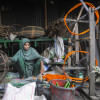Turning leaves into livelihoods: The story of Mohammad Abdul and his haat pakhas

A figure stood distinct amidst the crowd in the streets of Gulshan-2, just a few days before the festival of Eid-ul-Azha. In the sweltering heat – clad in ragged clothes and bearing the weight of tradition both literally and metaphorically – was Mohammad Abdul.
He was carrying a load of haat pakha – hand fans made with palm leaves – each woven with stories of a fading craft. So, what was he doing just before the happy occasion of Eid?
"I wanted to earn a little extra money to buy my children something nice," he replied.
Hailing from Kushtia, Mohammad Abdul has been making and selling haat pakhas for more than two decades now. Like Abdul, many people used to earn their livelihoods by making such pakhas – a tradition declining with time.

"We usually craft these pakhas from palm leaves. However, many in our village, especially the women, make nakshi pakhas. We have been making pakhas for generations now and frequently, come to the city in hopes of selling them," explained Abdul.
The haat pakha is not just a tool for battling the relentless heat but is a symbol of Bangladeshi heritage. These hand fans are typically crafted from palm leaves, featuring a sturdy yet flexible structure that provides a natural, cooling breeze — much needed in the tropical climate of our country.
Traditionally, these fans come in various forms – plain and adorned with elaborate naksha (designs). However, as technology advances and electric fans and air conditioners become more accessible, the demand for these handcrafted fans has dwindled, casting a shadow over artisans' livelihoods.
"Do you remember any particular story about haat pakha?" I asked, intrigued by the generational craft.
With a smile, Abdul's eyes lit up with nostalgia. "My grandmother used to tell me stories under the cool breeze of her pakha. Those were simpler times," he said.
"Summers were harsh, but a haat pakha was always within reach. My mother would use it to lull me to sleep or shoo away the flies while we ate." Abdul reminisced with teary eyes.
In rural areas, where many homes lack air conditioning and sometimes even electric fans due to power outages or economic constraints, these hand fans are invaluable. They are used to generate a breeze during the hot and humid days and nights, making the oppressive heat more bearable.
For many rural families, making and selling haat pakhas provides a supplementary income similar to Abdul but the winds of modernisation are challenging this age-old tradition. Abdul laments, "The young ones, even my children say there is no future in this. They might be right, but what about our past, our livelihoods?"

So, as the young generation, our role is pivotal – we are the bridge between the past and the future. One of the most direct ways we can support artisans like Mohammad Abdul is by purchasing their products.
For artisans like him, every haat pakha sold is not just a transaction but a lifeline. Buying one or two pakhas, whether for personal use, as gifts, or even as decorative pieces for homes and offices, can make a significant difference.
It is through these collective efforts that we can help preserve not just the craft itself but also the stories, traditions, and livelihoods associated with it – preventing this unique part of our heritage from fading into oblivion.

 For all latest news, follow The Daily Star's Google News channel.
For all latest news, follow The Daily Star's Google News channel. 








Comments